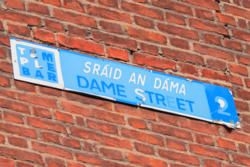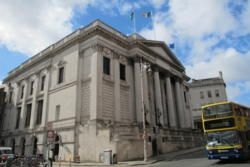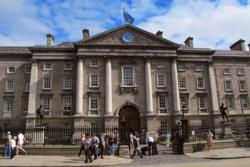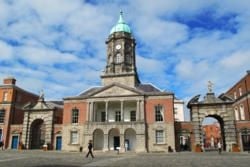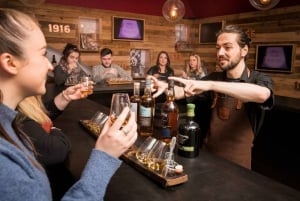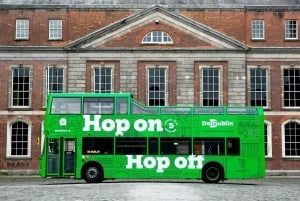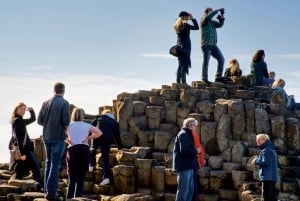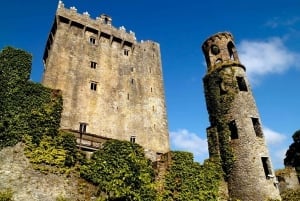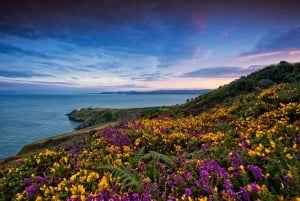Trinity + Dame Street Area
From St Stephen’s Green, a quick skip north along Grafton Street leads to College Green. Where Trinity’s inaugural class of 1592 nerds…ahem…students would have gazed across open fields, there’s now a hectic junction bordered by the College’s grand west front and the impressive façade of the Bank of Ireland.
A series of statues gives this area some character: philosopher and politician Edmund Burke and writer Oliver Goldsmith flank either side of the College’s main entrance; politician Henry Grattan is near the Bank; and at the head of Dame Street stands nationalist and poet Thomas Davis, author of popular ballad A Nation Once Again. This explains the quaint local nickname of the fountain over which he watches: ‘Urination Once Again’.
At the bottom of Grafton Street near College Green is a rather hideous bronze of Molly Malone, she of the cockles and mussels (which are faithfully depicted in the statue as well). In keeping with the tradition of droll nicknaming, the busty lady and her trusty wheelbarrow are simply known as ‘The Tart With The Cart’.
Trinity College itself occupies a healthy chunk of prime Dublin city-centre real estate. Visitors can wander freely through its leafy grounds, though by far the most visited part of the college is the Old Library which houses the spectacular Book of Kells - the illuminated masterpiece containing the four gospels of the New Testament, dating back over 1,200 years.
Upstairs is the imposing Long Room, where 200,000 of the oldest tomes out of the library’s three million or so titles are safely shelved in their musty, dusty glory.
Leaving the academic atmosphere of Trinity via the western entrance, you’ll find yourself on Dame Street - one of the city’s busiest streets. Due to its handy central location (so near Grafton Street and Trinity, bordering Temple Bar and only a five-minute walk to O’Connell Street), it’s heaving with humanity and traffic virtually all day.
From here you can access a number of local points of interest, three of which are located together, practically in one spot…
Dublin Castle, continuously occupied since its establishment in 1204 AD, has played a prominent role in Ireland's history. These days, it more prosaically hosts conference and dining facilities, but it’s still possible to take a guided tour of the prestigious State Apartments and Medieval Undercroft. On fine days, the Castle's gardens are a great place to recharge when you're in the midst of a hectic sightseeing schedule.
Within Dublin Castle’s gardens is the Chester Beatty Library, established in 1950 by Sir Alfred Chester Beatty to house his collections. More info on Sir Alfred can be found in the Glasnevin Cemetery section here. The Library as you find it today opened on February 7, 2000 - the 125th anniversary of Sir Alf’s birth. This art-museum-cum-library’s rich collections include manuscripts, prints, drawings, miniature paintings, rare books and decorative arts from Islamic, East Asian and Western traditions. The museum also offers numerous temporary exhibitions and contains a number of priceless objects.
Right beside (well, in front of) the Castle is City Hall. The vaults of this Georgian beauty now host the multi-media exhibition Dublin’s City Hall: The Story of the Capital. This traces Dublin’s development from before the Anglo-Normans invaded in 1170 to the present day. The exhibition entrance is located on the left-hand side of the building (as you face the columned front).
Photos, from top to bottom: College Green (from Trinity); Trinity College; Dame Street Sign; Dublin Castle; Chester Beatty Library; City Hall


